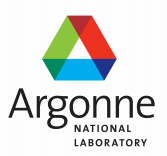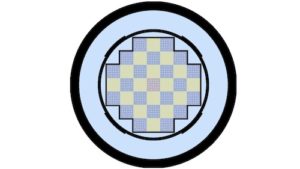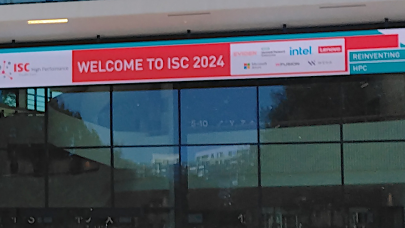June 9, 2021 — Understanding the detailed, in-depth physical behavior inside an operating nuclear reactor can be enhanced with simulations on a supercomputer that model the high-pressure, high-temperature and radioactive environment inside a reactor core.
 Scientists hoping to eventually build new generations of small modular nuclear reactors, or SMRs, need to be able to design and understand the behavior of these reactors in simulated environments before they can ever be constructed in reality. Large-scale high-resolution models yield better information that can drive down costs to build a new, intrinsically safe nuclear reactor.
Scientists hoping to eventually build new generations of small modular nuclear reactors, or SMRs, need to be able to design and understand the behavior of these reactors in simulated environments before they can ever be constructed in reality. Large-scale high-resolution models yield better information that can drive down costs to build a new, intrinsically safe nuclear reactor.
In a notable advance, scientists at the U.S. Department of Energy’s (DOE) Argonne National Laboratory have collaborated to develop a new computer model that allows for the visualization of a full reactor core at unprecedented resolution.
The ultimate research objective of the project, which was conducted under the auspices of the DOE’s Exascale Computing Project (ExaSMR), is to carry out the full-core multi-physics simulations on upcoming cutting-edge exascale supercomputers, such as Aurora, which is scheduled to arrive at Argonne in 2022. The progress achieved, published April 5 in the journal Nuclear Engineering and Design, marks an important milestone, which will hopefully inspire researchers to further integrate high-fidelity numerical simulations in actual engineering designs.
In a nuclear reactor, the whirls and eddies of coolant that flow around the fuel pins play a critical role in determining the reactor’s thermal and hydraulics performance and give much needed information to nuclear engineers about how to best design future nuclear reactor systems, both for their normal operation and for their stress tolerance.
A nuclear reactor core contains the fuel and coolant needed for the reactor to operate. The core is divided up into several bundles called assemblies, and each assembly contains several hundred individual fuel pins — which in turn contain fuel pellets. Until now, limitations in raw computing power had constrained models, forcing them to address only particular regions of the core.

“As we advance towards exascale computing, we will see more opportunities to reveal large-scale dynamics of these complex structures in regimes that were previously inaccessible, giving us real information that can reshape how we approach the challenges in reactor designs,” said Argonne nuclear engineer Jun Fang, an author of the study, which was published by ExaSMR teams at Argonne and Professor Elia Merzari’s group at Pennsylvania State University.
A key aspect of SMR fuel assembly modeling is the presence of spacer grids. These grids play an important role in pressurized water reactors, such as the SMR currently under consideration, as they create turbulent structure and enhance the capacity of the flow to remove heat from the fuel rods containing uranium.
Instead of creating a computational grid resolving all the local geometric details, the researchers developed a mathematical mechanism to reproduce the overall impact of these structures on the coolant flow without sacrificing accuracy. In doing so, the researchers can successfully scale up the related computational fluid dynamics CFD simulations to an entire SMR core for the first time.
“The mechanisms by which the coolant mixes throughout the core remain regular and relatively consistent; this enables us to leverage high-fidelity simulations of the turbulent flows in a section of the core to enhance the accuracy of our core-wide computational approach,” said Argonne principal nuclear engineer Dillon Shaver.
The strong technical expertise exhibited by the ExaSMR teams is built upon Argonne’s history of breakthroughs in the related research fields, particularly nuclear engineering and computational sciences. Several decades ago, a group of Argonne scientists, led by Paul Fischer, pioneered a CFD flow solver software package called Nek5000, which was transformative because it allowed users to simulate engineering fluid problems with up to one million parallel threads.
Most recently, Nek5000 has been re-engineered into a new solver called NekRS that uses the power of graphics processing units (GPUs) to accelerate the computational speed of the model. “Having codes designed for this particular purpose gives us the ability to take full advantage of the raw computing power the supercomputer offers us,” Fang said.
The team’s computations were carried out on supercomputers at the Argonne Leadership Computing Facility (ALCF), Oak Ridge Leadership Computing Facility (OLCF), and Argonne’s Laboratory Computing Resource Center (LCRC). The ALCF and OLCF are DOE Office of Science User Facilities. The research is supported by the Exascale Computing Project, a collaborative effort of DOE’s Office of Science and the National Nuclear Security Administration.
About Argonne Leadership Computing Facility
The Argonne Leadership Computing Facility provides supercomputing capabilities to the scientific and engineering community to advance fundamental discovery and understanding in a broad range of disciplines. Supported by the U.S. Department of Energy’s (DOE’s) Office of Science, Advanced Scientific Computing Research (ASCR) program, the ALCF is one of two DOE Leadership Computing Facilities in the nation dedicated to open science.
About Argonne National Laboratory
Argonne National Laboratory seeks solutions to pressing national problems in science and technology. The nation’s first national laboratory, Argonne conducts leading-edge basic and applied scientific research in virtually every scientific discipline. Argonne researchers work closely with researchers from hundreds of companies, universities, and federal, state and municipal agencies to help them solve their specific problems, advance America’s scientific leadership and prepare the nation for a better future. With employees from more than 60 nations, Argonne is managed by UChicago Argonne, LLC for the U.S. Department of Energy’s Office of Science.
The U.S. Department of Energy’s Office of Science is the single largest supporter of basic research in the physical sciences in the United States and is working to address some of the most pressing challenges of our time. For more information, visit https://energy.gov/science.
Source: Jared Sagoff, Argonne National Laboratory
























































